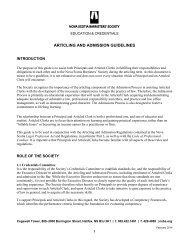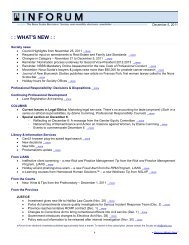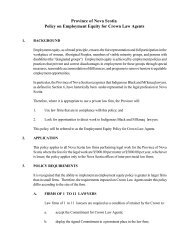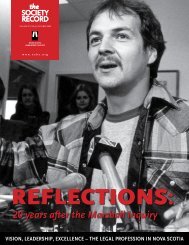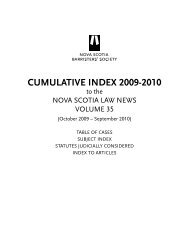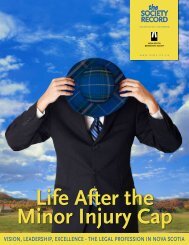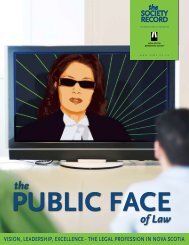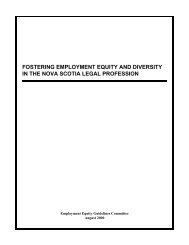SR Vol 25 No 1, January 2007 - Nova Scotia Barristers' Society
SR Vol 25 No 1, January 2007 - Nova Scotia Barristers' Society
SR Vol 25 No 1, January 2007 - Nova Scotia Barristers' Society
You also want an ePaper? Increase the reach of your titles
YUMPU automatically turns print PDFs into web optimized ePapers that Google loves.
An Enviable RecordThere have been many wonderful privileges in my legalcareer to date – one of the greatest of which has been theopportunity I have been afforded to serve the litigants ofthis province as an adjudicator of the Small Claims Court of <strong>No</strong>va<strong>Scotia</strong>, and, since September of 2001, as the Province’s first ChiefSmall Claims Court Adjudicator.Though it has gone through immense changes since my appointmentas an adjudicator in August of 1994, the Small Claims Court remainslargely as the forum of choice for “ordinary people” looking to resolvetheir civil disputes. For these litigants, the Small Claims Courtprovides quick and informal access to civil redress “in accordancewith the principles of law and natural justice” as provided for in s. 2of the Small Claims Court Act.To many, the Small Claims Court is their only available arbiter. Theprohibitive costs and lengthy delays associated with civil actions inthe Supreme Court of <strong>No</strong>va <strong>Scotia</strong> have rendered that forum wellbeyond the reach of those other than the wealthy and those whoseclaims lend themselves to representation through contingency feeagreement. Is it then any wonder that the jurisdiction of the SmallClaims Court has expanded, monetarily and otherwise, in recentyears, to the extent it has?There are many, I realize, within our profession who regard the SmallClaims Court as little more than some form of adjudicative lottery.They may regard the forum as one within which almost anythinggoes, in the evidentiary and argumentative senses. They may see theprocess as one which results in little more than “rough justice”. Theymay also conclude that decisions are rendered only on the basis ofmixed fact and myth and with little or no analytical consideration.How wrong those perceptions really are!Monetarily, the Small Claims Court’s jurisdiction now standsat $<strong>25</strong>,000. Additionally, the Small Claims Court is the primaryappellate tribunal for residential tenancy matters. It is also theprimary authority for the taxation of costs and legal accounts. The$<strong>25</strong>,000 monetary limit does not apply to those. Several adjudicatorshave, to date, taxed accounts which have ranged into the hundreds ofthousands of dollars, rendering lengthy and complex written reasonsfor decisions which have survived more than one level of appeal.To bring poignancy to the Small Claims Court’s expandingjurisdiction, the Supreme Court of <strong>No</strong>va <strong>Scotia</strong> (per: Warner, J.)recently reminded the adjudicators (and others), in Kemp v. Prescesky,[2006] N.S.J. <strong>No</strong>. 174, that $<strong>25</strong>,000 was very close to the annualaverage income of all adult <strong>No</strong>va <strong>Scotia</strong>ns. The Supreme Court’smessage was clear: as the Small Claims Court’s jurisdiction expands,so must its procedural formality. So what might change?As it’s now configured, the Small Claims Court is populated by nofewer than two dozen adjudicators, most of whom are appointedby the Governor-In-Council for terms of not less than five years.They come from many different geographical areas within theprovince, and their legal practicebackgrounds vary widely.Gavin Giles, Q.C.McInnes CooperMost of the adjudicators have inexcess of twenty years practice experience. A high proportion of themare Queen’s Counsel. Some possess graduate degrees in law. Someothers have combined their experiences in adjudication with formaltraining in mediation, arbitration and decision-writing. More than halfof the current sitting adjudicators have been presiding over the Courtfor more than ten years. Theirs is an exemplary record of communityand professional service and voluntarism. While paid for their “sittingtime”, most adjudicators spend three hours preparing and writingdecisions outside of court for every hour they spend sitting in it.In any given year, the Small Claims Court will collectively receiveupwards of 3000 claims. Of those, approximately two-thirds tothree-quarters will proceed to formal hearing. Of those, two-thirds tothree- quarters will result in written reasons for decision after varyingperiods of reflection. The balance are usually decided on the spot.Perhaps remarkably, fewer than three per cent of all Small ClaimsCourt decisions are taken on appeal to the Supreme Court of<strong>No</strong>va <strong>Scotia</strong>. Of those which are, only approximately one in nineresults in an outright reversal or an order for re-hearing. Orders forre-hearing are by far the predominant Small Claim Court appealremedy. Outright reversals are extraordinarily rare. That is, by anymeasure, an enviable record. It is one for which the Small ClaimsCourt, its adjudicators, the Department of Justice, and the otheradministrators of justice in this province, can be justifiably proud.That the Small Claims Court will continue to have its challenges isclear. Kemp has been a watershed and has presented the Small ClaimsCourt with something of a lightening rod. The future challenge willbe to both ensure the establishment of appropriate and acceptableprocedural safeguards, whilst at the same time maintaining theuniversal access which has been the hallmark of the Small ClaimsCourt’s twenty-five year history. The signal from the Supreme Courtof <strong>No</strong>va <strong>Scotia</strong> is that it is watching carefully.To that end, issues currently being examined by the <strong>No</strong>va <strong>Scotia</strong>Department of Justice’s Small Claims Court Options DevelopmentCommittee include pleadings, default judgment as opposed to “quickjudgment”, pre-hearing documentary disclosure, oral discovery,verbatim hearing records, costs, witness compellability, enforcementof Orders through contempt and like procedures, and the limitationof appeals to en banc panels of adjudicators.It is likely that through the options development process, in whichall of the Small Claims Court stakeholders are capably represented,the type of process we now know will change in manners difficult togauge at present. That change notwithstanding, the Small ClaimsCourt will continue to offer itself as a forum for which public accessis its most common feature.<strong>January</strong> <strong>2007</strong> <strong>25</strong>



